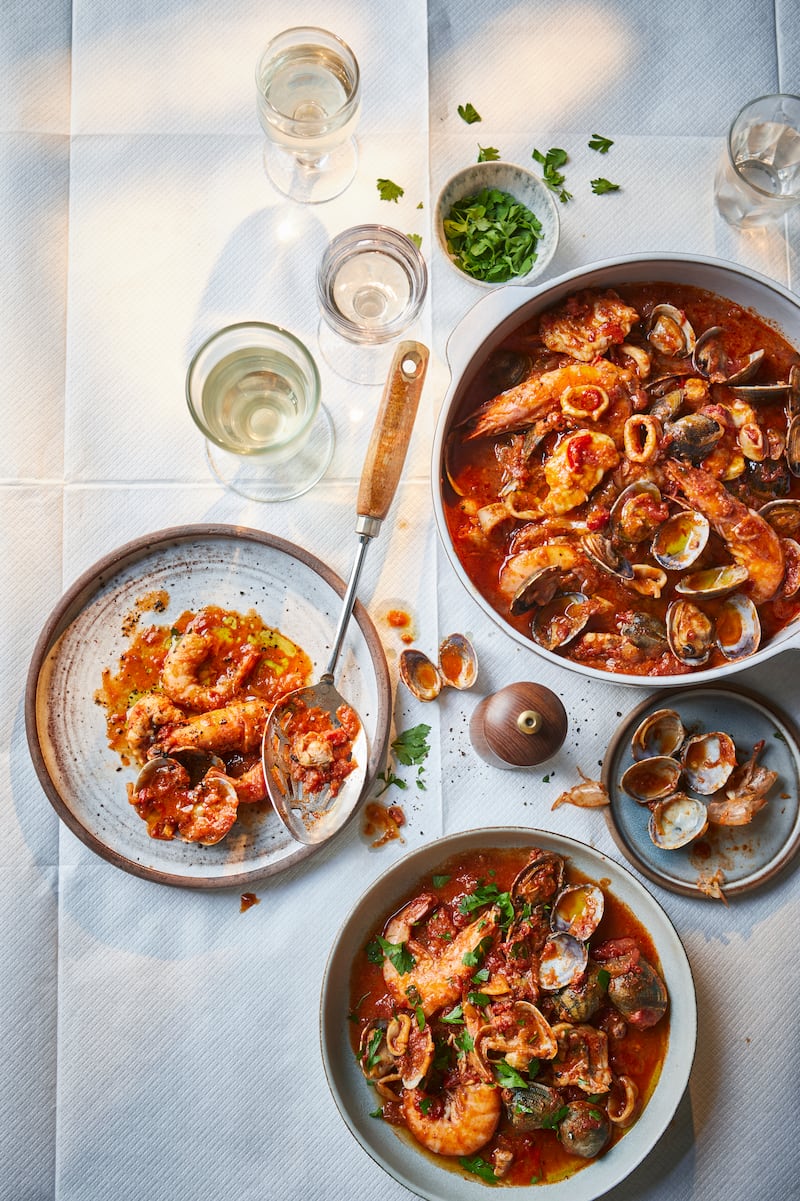“Seafood is excellent on a low-carb diet as it is high in protein for satiety and low in carbs,” says cookbook writer Katie Caldesi.
The dish also features nduja, “a spicy, spreadable salami that has a warm heat and just makes everything it touches a little more interesting,” she adds.
“Used here for an instant hit of garlic, chilli and umami, it is a brilliant background for the fish without overwhelming them. Versions of nduja can alter, so do taste yours to see if it is very spicy or salty, and adjust the amount you use accordingly. You can always add more later or add smoked paprika to taste.
“Serve on its own in bowls or with cauli-rice and low-carb bread on the side for mopping up the sauce. If buying frozen calamari, do read the label carefully; the cooked variety simply needs warming in the sauce rather than a slow-cook.”
Seafood and nduja stew
Ingredients:
(Serves 8)
4tbsp extra-virgin olive oil
80–100g nduja
4 garlic cloves, lightly crushed
2 onions, finely sliced
500g fresh, or frozen and defrosted, raw calamari (squid), cleaned and cut into 1cm rings
200ml dry white wine
3 × 400g cans Italian plum tomatoes, chopped
1tbsp tomato purée
250g clams or mussels or a mixture
1–2tsp smoked paprika (optional)
500g monkfish, cod or coley or other firm fish, cut into bite-sized pieces
250g raw prawns, heads left intact, shells and black veins removed
Small handful of parsley, leaves and stems roughly chopped
Salt and pepper

Method:
1. Heat the olive oil and 80 grams of the nduja in a frying pan (with a lid) over a medium heat for a few minutes, bashing the nduja with a wooden spoon to break it up. Add the garlic and onions, then continue to cook for around 10 minutes, stirring to prevent it burning, until the onion is soft.
2. Add the calamari to the pan and let it cook until the water is released from the calamari, about 10 minutes. When the calamari has a ‘bouncy’ appearance, add the wine and allow this to evaporate for five minutes. Add the tomatoes and the purée and bring the stew to a bubbling heat. Then lower the heat and simmer for at least one-and-a-half hours, partially covered, or until the calamari is soft.
3. Keep the clams or mussels in the fridge until you are ready to use them. Generally they are purged and cleaned when you buy them but to be sure, put them into a bowl of cold water and stir them through. Leave them for 20–30 minutes in a cool place (the fridge if your kitchen isn’t cool), stirring a few times to encourage them to release any grit. Pick over them, discarding any that remain open once tapped. Pull any fuzzy beards off the mussels. Discard any shellfish with broken shells. Drain and use straight away.
4. Taste the stew and add more nduja or smoked paprika for spice or salt and pepper. The stew can be cooled and kept for one to two days at this point, if it makes entertaining easier. Reheat until bubbling before continuing.
5. Just before serving, drop the monkfish, prawns and mussels, if using, into the hot stew with the lid on and continue to cook for around 10 minutes, or until the fish is cooked through, the prawns are pink and the clams or mussels have opened (discard any that haven’t). Serve straight away with the parsley scattered over.

The Diabetes Weight-Loss Plan by Katie Caldesi is published by Kyle Books, priced £22. Photography by Maja Smend. Available now.








